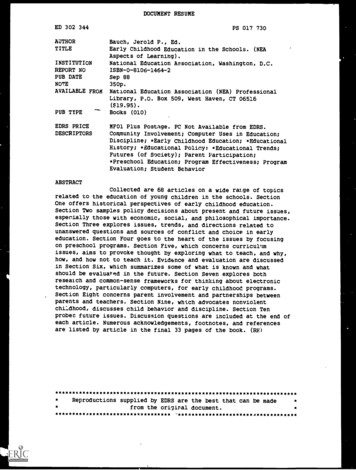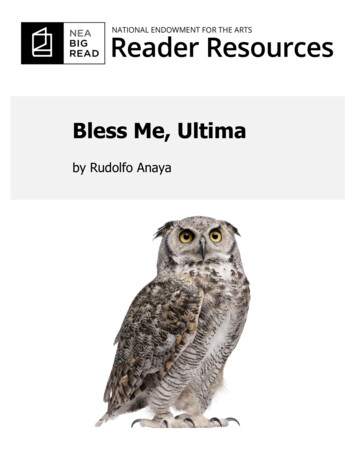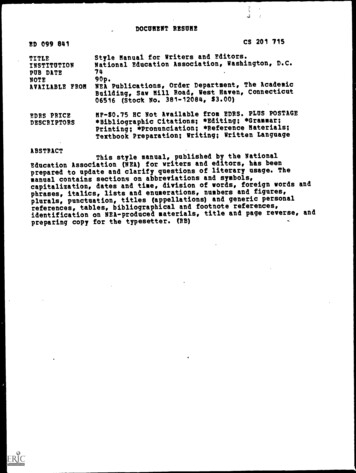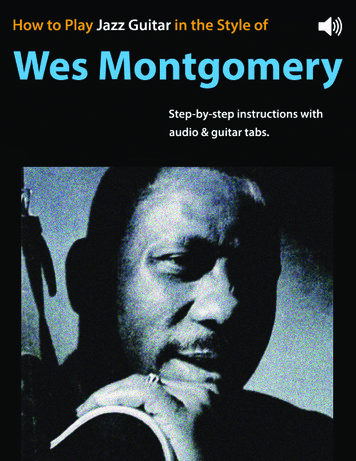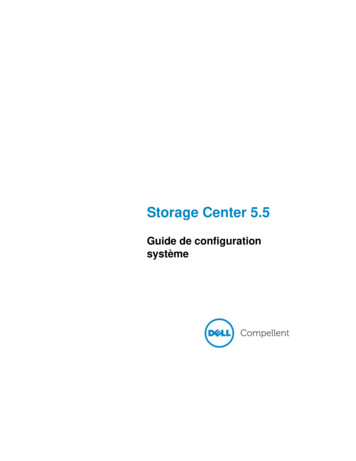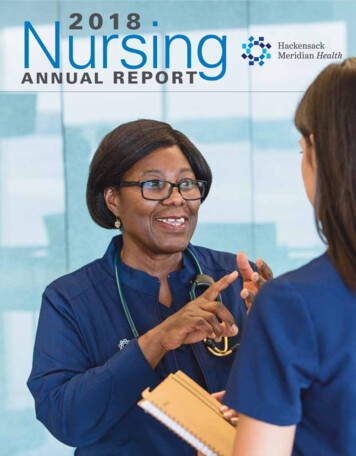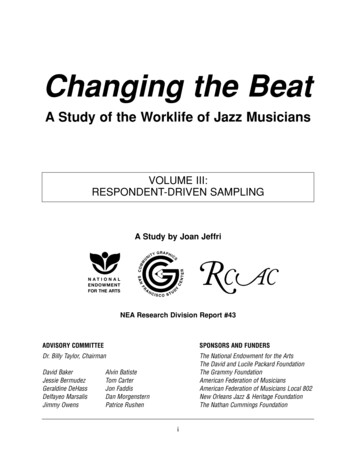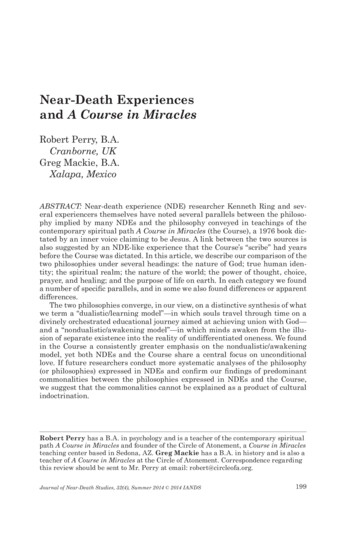
Transcription
Near- Death Experiencesand A Course in MiraclesRobert Perry, B.A.Cranborne, UKGreg Mackie, B.A.Xalapa, MexicoABSTRACT: Near-death experience (NDE) researcher Kenneth Ring and several experiencers themselves have noted several parallels between the philosophy implied by many NDEs and the philosophy conveyed in teachings of thecontemporary spiritual path A Course in Miracles (the Course), a 1976 book dictated by an inner voice claiming to be Jesus. A link between the two sources isalso suggested by an NDE-like experience that the Course’s “scribe” had yearsbefore the Course was dictated. In this article, we describe our comparison of thetwo philosophies under several headings: the nature of God; true human identity; the spiritual realm; the nature of the world; the power of thought, choice,prayer, and healing; and the purpose of life on earth. In each category we founda number of specific parallels, and in some we also found differences or apparentdifferences.The two philosophies converge, in our view, on a distinctive synthesis of whatwe term a “dualistic/learning model”—in which souls travel through time on adivinely orchestrated educational journey aimed at achieving union with God—and a “nondualistic/awakening model”—in which minds awaken from the illusion of separate existence into the reality of undifferentiated oneness. We foundin the Course a consistently greater emphasis on the nondualistic/awakeningmodel, yet both NDEs and the Course share a central focus on unconditionallove. If future researchers conduct more systematic analyses of the philosophy(or philosophies) expressed in NDEs and confirm our findings of predominantcommonalities between the philosophies expressed in NDEs and the Course,we suggest that the commonalities cannot be explained as a product of culturalindoctrination.Robert Perry has a B.A. in psychology and is a teacher of the contemporary spiritualpath A Course in Miracles and founder of the Circle of Atonement, a Course in Miraclesteaching center based in Sedona, AZ. Greg Mackie has a B.A. in history and is also ateacher of A Course in Miracles at the Circle of Atonement. Correspondence regardingthis review should be sent to Mr. Perry at email: robert@circleofa.org.Journal of Near-Death Studies, 32(4), Summer 2014 2014 IANDS199
200JOURNAL OF NEA R-DEATH STUDIESKEY WORDS: near-death experience; A Course in MiraclesIn this article, our purpose is to compare the philosophy that manynear-death experiences (NDEs) seem to imply with the philosophyconveyed through the teachings of the spiritual text A Course in Miracles (“the Course” or “ACIM”; Foundation for Inner Peace, 2007). Aslong-time Course teachers who also share an interest in NDEs, ourobservation is that despite some notable differences, which we document below, there are a number of parallels between these two sets ofinformation. These parallels are especially interesting given the factthat NDEs and A Course in Miracles are essentially independent ofeach other: The Course was completed in 1972, before NDEs came topublic attention in Raymond Moody’s (1975) Life After Life, and sincethen the Course has not been a significant cultural influence. Thus,it seems unlikely that reports of NDEs influenced the Course or viceversa.In our view, this similarity carries possible implications for both theCourse and NDEs. At the very least, it raises the question of wherethe similarity comes from. How could A Course in Miracles and manyNDEs independently agree on so much about God, humans’ true identities, the spiritual realm, and the purpose of life on earth, especiallywhen these agreements fall outside of prevailing Western culturalexpectations?What Is A Course in Miracles?A Course in Miracles is a contemporary spiritual path in the form of abook. Structured like an academic course, it consists of three volumesbound together: the Text, which presents the theory; the Workbook,which consists of a year of daily exercises that train students in applying the theory; and the Manual for Teachers, which is designed toassist teachers of this course.The Course was “scribed” from 1965 to 1972 through a process of“inner dictation”—of a voice that claimed to be Jesus—by Helen Schucman (1909–1981) with the assistance of William Thetford (1923–1988), both of whom were psychologists at the Columbia- PresbyterianMedical Center in New York City. (For more on the Course’s scribing,see Vahle, 2009; Wapnick, 1999; and Skutch, 2004,) The book wasoriginally published in 1975, the same year as Moody’s seminal workon NDEs, Life After Life.
ROBERT PERRY, B.A. & GREG MACKIE, B.A.201Since its publication, the Course has sold over a million copies. It isgenerally studied either by students alone or in the context of looselyorganized study groups, often with the aid of books written about it.Yet although the Course has experienced brief periods of relative popularity, such as the period following the 1992 publication of MarianneWilliamson’s bestselling Course-based book A Return to Love, it remains a small phenomenon with little influence on the general publicbeyond the New Age movement and alternative spiritual circles.Links between NDEs and A Course in MiraclesAs interpreters and teachers of A Course in Miracles, we often hearthat a particular book or teaching is “just like” the Course. Historically, however, we have been naysayers, pointing out that the similarities are not nearly as great as people seem to think. The similarities,in our view, are often based on popular interpretations of the Course,whereas our own approach has been to set aside conventional wisdomabout the Course and try to uncover, through careful study and analysis, what it is really teaching.However, when we began looking into NDEs, our experience wassurprisingly different. Again and again, we found in NDEs specificideas and overall orientations that we had discovered in the Courseand had put forward as corrections of conventional wisdom about theCourse. As a result, in our teaching, although we still downplay theparallels between the Course and other teachings, we frequently reference NDEs as dramatic illustrations of particular Course concepts.To compare the philosophy of A Course in Miracles and NDEsobviously requires an understanding of each one by itself. With theCourse, exploring and communicating its philosophy has been ourlife’s work, so we feel on firm ground there. With NDEs, however, it isnot so simple. Not only are we newer to this topic, but it is inherentlymore difficult to get one’s arms around. To date there has been no systematic study of the philosophy of NDEs, and therefore it has not beenestablished that there is a unified philosophy expressed in them. Thefeatures that parallel A Course in Miracles are so prevalent that theyseem to us to be part of a kind of “mainstream” of NDEs, but for thetime being that possibility will have to remain a subjective impressionthat awaits verification.
202JOURNAL OF NEA R-DEATH STUDIESPrevious Discussions of NDEsand A Course in MiraclesAn initial link was drawn between NDEs and ACIM by researcherKenneth Ring in his article “Solving the Riddle of Frightening Near- Death Experiences: Some Testable Hypotheses and a PerspectiveBased on A Course in Miracles” (1994). In this article, Ring offereda Course-based explanation for distressing NDEs—specifically, forwhat he called “inverted” NDEs and hellish NDEs (not for “meaningless void” experiences, which he considered not to be true NDEs, butto be reactions to inadequate anesthesia). He pointed out that in theCourse’s view, the only thing that is ultimately real is the realm ofpure love—what the Course calls “Heaven” (the realm of God) andwhat, according to him, near-death experiencers (NDErs) call “theLight.” On the other hand, our conventional self-image—what theCourse calls the ego—is an illusory construct rooted in fear, a construct the existence of which depends on denying the Light.This picture of reality leads directly to Ring’s Course-based explanation for distressing NDEs. He posited that if one is strongly identified with one’s ego and its fear of dissolution,such an individual’s emotional state will then tend to generate imagesconsonant with that fear, which will only cause it to strengthen. Theperson will therefore continue to feel very menaced [by the NDE], ashe or she is indeed threatened with extinction—as a separate ego. . . .According to A Course in Miracles, then, it comes down to this: Ifyou are still clinging to your little island of make-believe, your ego,when you enter into death, you will experience its own fear, perhaps tothe point of terror. If you can let go, however . . . you will find yourselfone with the Infinite Light of Life (1994, pp. 15–16).In Ring’s view, then, just as fear of ego dissolution can cause an NDEto “invert” and become distressing, so letting go allows the experienceto “convert” back into the much more frequently reported pleasurableNDE.Whether or not Ring’s view explains distressing NDEs, it is a logical extension of what the Course teaches. Indeed, in the Course thereis a reference to a very similar fear reaction when approaching “thelight” in meditation:While you practice in this way, you leave behind everything that younow believe, and all the thoughts that you have made up. Properlyspeaking, this is the release from hell. Yet perceived through the ego’seyes, it is loss of identity and a descent into hell.
ROBERT PERRY, B.A. & GREG MACKIE, B.A.203If you can stand aside from the ego by ever so little, you will haveno difficulty in recognizing that its opposition and its fears are meaningless (Foundation for Inner Peace, 2007, Workbook, p. 69).Here, then, is an explanation for resistance to meditation that isvery similar to Ring’s explanation for frightening NDEs: The ego fearsthe light because the light threatens it with extinction. To the ego,then, the ascent into light is a descent into hell. But if one can let goof the ego and its resistance, which are nothing but meaningless illusions, the experience will convert into the joyful one that is its naturalform.In contrast to Ring’s thesis, the late Kenneth Wapnick, a prominent Course interpreter, emphasized what he considered a theologicalincompatibility between the Course and NDEs (Wapnick & Wapnick,1995). In view of the Course’s teaching that the body is not real, Wapnick claimed that it makes no sense to speak of leaving the body andthen, once out of the body, finding a peace that was not available inthe body. Both leaving the body and finding a peace inaccessible whilein the body, he said, would mean that the body is real. “How can oneleave one’s body, travel through a tunnel, and greet a great light, ifone were never in the body in the first place?” (Wapnick & Wapnick,1995, p. 40). Therefore, though these experiences may be helpful, theyare better understood as being subjectively “projected from the mindonto the body and its world of life, death and near death” (Wapnick &Wapnick, 1995, p. 41). Seeing NDEs as real and as something to seekwould compromise the goals of the Course:Holding up near-death experiences to be idealized and sought for (aswas depicted in the popular movie Flatliners) actually serves well theego’s fundamental strategy of first making the body real, and thenturning it into a repulsive thing. This sets up a situation in whichpeople would wish to be free of its prison of darkness, yearning to escape into the non-corporeal light. And all the while, the ego’s thoughtsystem of separation, guilt, and specialness nestles comfortably in themind, protected by the belief that there is indeed a body that is real,and one that truly exists in the physical world. (Wapnick & Wapnick,1995, pp. 41–42)Although we acknowledge that the Course teaches that the body isunreal, we do not think this teaching means that taking NDEs moreor less at face value is somehow at odds with the Course. Wapnick’s interpretation here is an application of his larger interpretive approach,which we believe is highly problematic. This approach holds up the concept of “nonduality”—that only pure, undifferentiated spirit is real—
204JOURNAL OF NEA R-DEATH STUDIESas a kind of measuring stick for what the Course really teaches. As aresult, a number of key elements within the Course itself that appearincompatible with this nonduality are automatically reinterpreted as“metaphors” that are designed to veil the truth from minds that wouldbe threatened by it (Perry, Mackie, & Watson, 2004, pp. 55–89). Ourinterpretive approach, in contrast, rests on the many statements inthe Course itself that emphasize that its language is designed to beclear and unambiguous, that “this is a very practical course, and onethat means exactly what it says” (Foundation for Inner Peace, 2007,Text, p. 159), and that it values a minimum of symbolism because“symbolic” means “open to many different interpretations” (A Coursein Miracles urtext, 2003, Text, p. 124), which is the opposite of clear.As a result, in our view Wapnick’s approach ends up labeling asantithetical to the Course ideas that are actually an important part ofit and that are presented by it as straightforward teachings. We thinksomething similar happened with Wapnick’s treatment of NDEs. Justas his measuring stick of strict nonduality labeled authentic parts ofthe Course as incompatible with the Course, so that same measuringstick labeled NDEs as incompatible with the Course, whereas to usthey instead seem to be surprisingly compatible with it.We see this compatibility in a passage about death from a supplement to the Course that Helen Schucman scribed in 1977 (Foundationfor Inner Peace, 2007, Song of Prayer), which approvingly mentionsthe very things that Wapnick objected to: leaving the body and finding peace in a realm outside the body. Speaking of how death is experienced by a truly healed mind, this passage speaks of the body asbeing “discarded as a choice, as one lays by a garment now outworn”(Foundation for Inner Peace, 2007, Song of Prayer, p. 17). It then goeson to say,We thank the body, then, for all the service it has given us. But we arethankful, too, the need is done to walk the world of limits, and to reachthe Christ in hidden forms and clearly seen at most in lovely flashes.Now we can behold Him without blinders, in the light that we havelearned to look upon again.We call it death, but it is liberty. . . . Now we go in peace to freer airand gentler climate, where it is not hard to see the gifts we gave weresaved for us. For Christ is clearer now; His vision more sustained inus; His Voice, the Word of God, more certainly our own. (Foundationfor Inner Peace, 2007, Song of Prayer, pp. 17–18)Here, then, we have found in the Course material itself the veryelements that Wapnick objected to in NDEs: leaving the body and go-
ROBERT PERRY, B.A. & GREG MACKIE, B.A.205ing “in peace to freer air and gentler climate.” Further, the referencesto the body as a “garment” that can be discarded, to seeing the light“without blinders,” and to seeing clearly that “the gifts we gave [others] were saved for us” seem quite reminiscent of specific elements ofthe classic NDE (Zingrone & Alvarado, 2009, pp. 18–21). This kind ofcompatibility between the Course and NDEs sets the stage for whatwill be repeatedly seen below.A Near- Death- Like Experience in the Lifeof the Course’s Scribe: Helen Schucman’sSubway ExperienceIt turns out that the scribe of the Course herself, Helen Schucman,had a near-death-like experience in 1938, one whose ideas and imagery are echoed in the Course itself. It happened in the New York subway. Helen’s subway car was full of noisy people and revolting smells;recounting the experience, she said, “I was finding the whole situationincreasingly disgusting, and closed my eyes to shut it out, feeling sickto my stomach” (Wapnick, 1999, p. 47). That was when the experiencebegan:And then a stunning thing happened. It was very brief. . . . An accurate account of what happened is impossible. As an approximation,however, I can say that it was as though a blinding light blazed upbehind my closed eyes and filled my mind entirely. Without openingmy eyes, I seemed to be watching a figure of myself as a child, walkingdirectly into the light. The child seemed to know exactly what she wasdoing. It was as if the situation were completely familiar to her. Fora moment she paused and knelt down, touching the shining groundwith elbows, wrists, and forehead in what looked like an Eastern gesture of deep reverence. Then she got up, walked to the right side andknelt again, this time resting her head as if leaning against a giganticknee. The feeling of a great arm reached around her and she disappeared. The light grew even brighter, and I felt the most indescribablyintense love streaming from the light to me. It was so powerful that Iliterally gasped and opened my eyes.I saw the light an instant longer, during which I loved everyone onthe train with that same incredible intensity. Everyone there was unbelievably beautiful and incredibly dear. Then the light faded and theold picture of dirt and ugliness returned. (Wapnick, 1999, pp. 47–48)Afterward, Helen described the experience to her husband, who dismissed it as inconsequential and suggested that she forget about it.
206JOURNAL OF NEA R-DEATH STUDIESThis she did, and for years did not think about it at all. Years later,she began to scribe the Course, a task that she regarded as her life’spurpose, an assignment given to her by God.This experience, of course, was not an NDE, because Helen was notnear death. However, as the following points illustrate, her experienceshares many parallels with what NDErs have experienced (Zingrone& Alvarado, 2009, pp. 18–21): Helen mentally exited an unpleasant earthly situation and thenexperienced a higher realm that she found ineffable, that is, impossibleto adequately describe. In this realm, she approached a light that she understood to be God. This light, though not a human form, was personal and had elements ofa human form. She drew closer and closer to this light, was embraced by it, and thenfully united with it. Though she had no conscious memory of such an experience happeningbefore, the experience felt strangely familiar to her. Indescribably intense and powerful love streamed from the light to her. She experienced a great intensity of emotion. Afterward, she briefly saw others through the eyes of this love she hadreceived from God. When she later described the experience to someone close to her, hedismissed it, and as a result, she put it out of her mind for years. Eventually, though, it resurfaced in the form of a spiritual function(scribing ACIM), a function that she felt was a life purpose given her byGod.The similarities between the features of Helen’s experience andthose of many NDE accounts are so great that if Helen’s experiencehad been accompanied by a medical crisis, it would very likely be classified as an NDE. Here, for instance, is Cynthia Prueitt’s NDE account, which is similar in its specific contents:The next thing I remember was being introduced into a room that wascompletely and brilliantly white. There was a man sitting on a chairthat resembled a chair-type throne.Seeing this man with a beard sitting there, I ran up to him andclimbed on his knee. He gathered me in his arms and . . . He justbegan to comfort me. He gave me such a warm, warm feeling of loveand . . . I’ve never felt anything like it. It was warm, it was love, it wasjoy—I didn’t want it to end. It was the most thrilling feeling I had everexperienced, before or since. (Lundahl & Widdison, 1997, p. 124)Helen’s subway experience appeared to be a significant precursorof the Course. Indeed, she states in her autobiography that “[s]everal
ROBERT PERRY, B.A. & GREG MACKIE, B.A.207times” in the weeks right before the Course began coming throughher in the fall of 1965, “I felt something like the subway experienceof years before, although with much less intensity” (Schucman, 2009,p. 39). On an inner level, then, Helen’s subway experience and theCourse itself seem closely related. Given the likeness of her subwayexperience to NDEs, the relationship between her subway experience and the Course suggests a close connection between NDEs andthe Course. Thus, even though a case cannot be made for NDEs andthe Course influencing each other via culture, there may be a kind ofNDE influence within A Course in Miracles itself. Interestingly, thereis also the possibility of a kind of Course influence within NDEs, asNDErs on occasion report receiving communication and even teachingfrom Jesus, the ostensible author of the Course.NDErs Make the LinkIt is not just researchers like Kenneth Ring and Course teachers likeourselves who have seen a connection between NDEs and A Coursein Miracles. NDErs themselves sometimes have made that link. Nowthat I (Perry) regularly mention NDEs in my Course teaching, when Ispeak publicly on the Course NDErs in the audience will often speakup, and they clearly see an overlap between their experiences and theCourse. However, rather than quote from a wide array of NDErs, wehave selected just a few quotes from individuals who have some visi bility in the NDE community.In 1952 Jayne Smith had an NDE during childbirth. In the 60 yearssince, she has shared her NDE widely, including on The Oprah Winfrey Show and Charlie Rose television programs. She has served onthe Board of IANDS and has been a keynote speaker at its annualconference. She currently speaks at Beebe Medical Center in Lewes,Delaware to nurses’ meetings, patient support groups, and the generalpublic. Here is her account of the connection between her NDE and theCourse:Back in 1952 when I had my NDE, I was given what to me were incredible bits and pieces of knowledge. I knew beyond all doubt thateverything being given to me was total truth even though I’d neverbefore been exposed to these ideas. You can imagine my excitementand my joy when in 1979 I discovered A Course in Miracles! Thesemagnificent Truths which had changed my worldview completelysome 27 years before were in the pages of these three books whichcomprised A Course in Miracles. I especially remember passages like“I am not a body. I am free” and “Teach only love for that is what you
208JOURNAL OF NEA R-DEATH STUDIESare” and, of course, dozens and dozens of references to our sinlessness, our oneness with God and our purpose in life being all aboutlove. In fact it’s all about love. Everything! Love is the ground of ourbeing, the absolute bottom line of all there is, and there are passagesin ACIM that made my heart practically scream “Yes, yes, yes, yes, Iknow this. I was told this in my NDE.” My NDE has always been myNorth Star and there was never anything in the Course that conflictedwith what my NDE had taught me. The Course simply expanded myunderstanding of those Truths. I have never felt so at home in anywritten work. A Course in Miracles was, is and always will be oneof the great blessings in my life. (J. Smith, personal communication,August 26, 2013)Barbara Harris Whitfield had two NDEs as a result of complications from back surgery in 1976. She has long been active in the fieldof near-death studies in many ways: as a member of the IANDS Boardof Directors and its Executive Board, as a research assistant withpsychiatrist Bruce Greyson at the University of Connecticut MedicalSchool, as a teacher at Rutgers University’s Institute for Alcohol andDrug Studies, and as the author of Spiritual Awakenings: Insights ofthe Near- Death Experience and Other Doorways to Our Soul (1995)and The Natural Soul (2010). Here is her account:My life review showed me my ego and how to get out of its pain. ThisEnergy (God) that was holding me let me see through Its Eyes andIts Heart, so that I understood that my ego wasn’t me. There was noattempt to denigrate it, but to show over and over that it isn’t real.I understood that the only part of me that is real and will exist longafter I die—in fact it is eternal—is my Soul (the part of me that ispure Spirit).Then when my husband Charlie and I studied the Course together,and when we taught it, to me it was a continuation of what I hadlearned in my life review. Both NDEs and the Course are what I call“ego busters.” Indeed, the Course has the most sophisticated description of the ego and how to get out of its inherent pain. The Course alsohad the same perspective as my NDE on what is real and eternal inme. Both, I believe, are leading us to the place where we eventuallywake up to the realization that at our core we are unconditional love.Unconditional love is what I experienced in my NDE and what theCourse has helped me to fine tune, through taking off my rough edges,so I can continue to grow and be THAT.One last point: When I came back from my NDEs, I knew that Ihad been with the most amazing Intelligence ever!!! It was a Wisdomthat was far beyond ordinary human capability. And when I read theCourse, I feel the same astronomically brilliant Entity—call It whatever you want. Both NDEs and ACIM are from a far more intelligent
ROBERT PERRY, B.A. & GREG MACKIE, B.A.209perspective than we humans possess. They are so far beyond anythingwe humans could ever figure out. This Intelligence is big—bigger thanmy little mind can comprehend, but my heart grasps It with gratitude. (B. H. Whitfield, personal communication, July 10, 2013)Finally, we know of one case in which the Course was featuredwithin someone’s near-death experience itself. In 2008, physician Rajiv Parti was Chief of Anesthesiology at Heart Hospital in Bakersfield, California. During a surgery for a severe infection following anearlier surgery, he left his body. He soon found himself in a hellishregion and realized that he was in this environment because he hadled a self-centered and materialistic life. However, after he ferventlywished that he could live differently, the NDE turned around. He sayshe was then led by his deceased father through a tunnel, after whichhe merged with “the Light Being” and was told by It that he would begiven life back, but “ONLY to live it differently.” He was told he wouldhave to “leave anesthesiology and materialism behind,” and becomea healer. “The Light Being,” he says, “gave me glimpses of my future:writing books, speaking to audiences, helping many people.” Directlyon the heels of these instructions for his new life, his NDE concludedon an enigmatic note:As I accepted what the Light Being was showing me, some wordsseemed to flash in the sky above me. They read “A Course In Miracles.” At that time, being born into a Hindu family with my sense ofreligion and spirituality being dominated by my own Hindu culturalexperience, I had no idea what those words meant. [He reiterated thisin a talk in Sedona, Arizona, saying, “I remember very vividly I had noidea what they meant.”] I have since discovered this to be a spiritualbook popularized by Marianne Williamson in which the themes of loveand forgiveness are taught with intelligence and love.Finally, I became aware, with every fiber of my being, that myearthly life was being given back to me so I could help others whowere suffering from chronic pain, addiction and depression.My next memory is of waking up in the recovery room. (Parti, 2014)Given that seeing the words “A Course In Miracles” came directlyafter the instructions to return to life to teach a healing message,Parti has concluded that the ideas in the Course are meant to be thebasis of his ministry (R. Parti, personal communication, October 5,2013). And based jointly on his NDE and on the Course, he now seeshis message as summarized in these three words: “Forgive, Love,Heal.” He has since left his anesthesiology practice and immersedhimself in the study of the Course. He has also been busy sharing
210JOURNAL OF NEA R-DEATH STUDIEShis NDE, at the 2013 IANDS Conference and with IANDS and othergroups around the U.S.Here is an NDE, then, that contained the familiar theme of theNDEr being told he had a mission to fulfill. In this case, the NDEitself apparently signaled that the philosophical basis for that missionwas meant to be A Course in Miracles.Parallels and Differences Between NDEsand A Course in MiraclesIn this section, we examine the relationship between the philosophiesimplied or directly stated in NDEs and in the Course, under severalcategorical headings. In each category, we will first provide some representative quotes from both sides. Because we have not found in theprofessional literature a systematic study of the philosophy revealedin NDEs, we have no way of documenting how representative a givenNDE quote might be. All we can say at this point is that the quotes wehave selected seem to us to be within the range of what many NDErssay—a conclusion that has been supported by reviewers of this articlewho are experts in the field of near-death studies (J. Holden, personalcommunication, October 2, 2014; J. Long, personal communication, October 2, 2014; B. Greyson, personal communication, October 7, 2014).NDE accounts will be indicated by the name of the experiencer, andCourse passages by the word “Course.”We will then attempt to capture the parallels we see, in the formof a composite summary, printed in italics. In each such summary,we carefully composed each element to accurately reflect both NDEsand the Course. Space does not permit us to support every detail withquotes, because each sentence in our account of the parallels is basedon a number of NDEs and a pattern of Course passages. We hope,however, that the examples we do provide will suggest the overall veracity of our summaries. Finally, where applicable, we will explorenoteworthy differences that we see between the two.The Nature of GodRepresentative QuotesPeggy:I clearly and instantly knew the light was not justa Light but was ALIVE! It had a personality andwas intelligence beyo
contemporary spiritual path A Course in Miracles (the Course), a 1976 book dic - tated by an inner voice claiming to be Jesus. A link between the two sources is also suggested by an NDE-like experience that the Course’s “scribe” had years before the Course was dic
